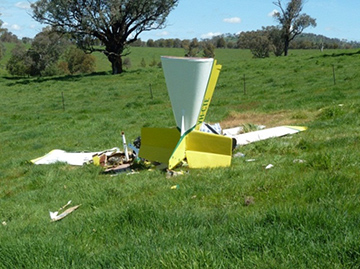
On the morning of Saturday 5 October 2013, the pilot of a Rand Robinson KR-2 aircraft, registered VH-CTE, took off from an airstrip on private property 12 km west of Tumut, New South Wales. The pilot was reported to have intended flying to Holbrook, New South Wales, and return home the following evening.
When the pilot had not returned by early Sunday evening, authorities were notified. A search located the aircraft wreckage in the early morning on 7 October 2013. The wreckage was found about 450 m east-north-east of the departure airstrip. The pilot was fatally injured and the aircraft was destroyed by impact forces.
The pilot’s decision not to have proper maintenance performed on the aircraft most likely contributed to the ejection of the spark plug, resulting in the accident.
Data from a global positioning system receiver recovered from the wreckage identified that the pilot turned back towards the departure airstrip shortly after take-off. During the attempt to land back on the airstrip, the aircraft likely entered a stall. The pilot was unable to recover the aircraft before impacting terrain.
The ATSB’s examination of the wreckage found that a spark plug had been ejected from its respective cylinder head mount. The failure of the cylinder head spark plug mount was probably the result of an incorrectly installed thread insert. There were reports and evidence that the pilot maintained and modified the aircraft, despite not being qualified or authorised to do so. As well, in the previous 2 years, an authorised maintainer had not completed the required regular aircraft maintenance.
The pilot’s decision not to have proper maintenance performed on the aircraft most likely contributed to the ejection of the spark plug, resulting in the accident.
Safety message
Unauthorised maintenance increases the risk of mechanical failure. This, in turn, reduces the level of safety and increases the risk of injury or death.
Authorised aircraft maintenance is mandated to assure a level of safety for aircraft operations. That directive also identifies the requisite qualifications for the maintainer.
As well, managing airspeed and bank angle is critical to preventing an aerodynamic stall following partial engine failure after take-off. Research shows partial engine power loss is more complex and more frequent than a complete engine power loss. These accidents are typically a result of the aircraft entering an aerodynamic stall from a height where recovery is not possible.
More information on managing partial power loss after take-off is available from the ATSB’s avoidable accident web page.


